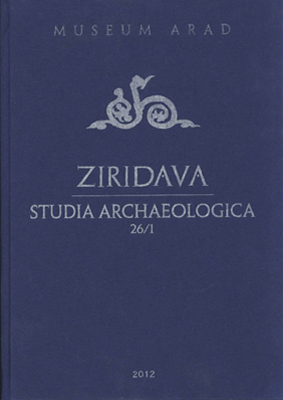Tombs with Jewels in the Byzantine Tradition
Discovered on the Present-Day Territory of Romania,
North of the Danube
(End of the 11th Century–the 14th Century)
Tombs with Jewels in the Byzantine Tradition
Discovered on the Present-Day Territory of Romania,
North of the Danube
(End of the 11th Century–the 14th Century)
Author(s): Silviu OţaSubject(s): Archaeology
Published by: Editura Mega Print SRL
Keywords: tomb; earring; ring; bracelet; diadem; necropolis
Summary/Abstract: Th rough the present study I aimed at selecting tombs with jewelry items of Byzantine infl uencedated to the 11th–14th centuries, found on the present-day territory of Romania, except Dobrudja, since thelatter was included in the Empire during several periods. Overall, such jewels were discovered in 116 complexespublished to a larger or lesser extent. As for the number of discovery sites, to the present state of research oneknows of 54 possible necropolises (see Pl. 1).I also wanted to see if such fi nds are concentrated in certain regions and if they are connected to certainpeculiarities of funerary rite and ritual. I thus analyzed the funerary rite, the location of the necropolises,the presence or absence of religious monuments and the main aspects of the funerary rituals (single burials,orientation of funerary complexes, position of the bodies and members inside the tombs and the location ofinventory items).From the perspective of the items’ chronology and spread, one can note that the earliest items of jewelryand dress accessories are mainly located in the mountain area of Banat and in Oltenia, thus in the close proximityof the Byzantine-Hungarian border, in an area that neither of the two states clearly controlled. In Walachiaand Moldavia the earliest items are concentrated on certain sites, but theybare few in numbers and often laterthan those in Oltenia and Banat. As an exception one can note the items concentrated in the area of Dridu-Fierbinţi and some of those in the northern half of Moldavia. Considering the presence of Turkic populationsthere, I suspect that the absence of such items is due to the domination of these populations. In support of thisstatement one can mention the existence of tombs belonging to nomad populations mainly concentrated insouthern Moldavia and Walachia. Th e situation was preserved until around the fi rst third of the 13th century.After this period, the number of jewels of Byzantine infl uence drops signifi cantly in Banat. Th is does notindicate a decreased infl uence of art in the Byzantine tradition, but possibly some new legislation in the Kingdomof Hungary that forbade placing such valuable objects in tombs. Th e phenomenon can be noted in eastern Banat atthe time the Banat of Severin was founded. Isolated cases and the typology of the items prove that the productionof Balkan items of jewelry continued and even became more diverse during the 13th and 14th centuries. Outsidethe Carpathians, the number of such objects nevertheless increased signifi cantly, including those areas where theywere scarce during the previous chronological interval. Th is statement is supported by the discovery of jewelryitems in settlements and the discovery of treasures and casting molds (in Coconi for example).Another aspect worth mentioning is that in most of the necropolises that included jewelry items ofByzantine tradition, the bodies were placed with arms in position E or its sub-variants. Th is might indicate thatthere was a strong connection between population groups wearing Balkan clothes and possibly heretical beliefs.
Journal: Ziridava. Studia Archaeologica
- Issue Year: 26/2012
- Issue No: 1
- Page Range: 123-142
- Page Count: 19
- Language: English

